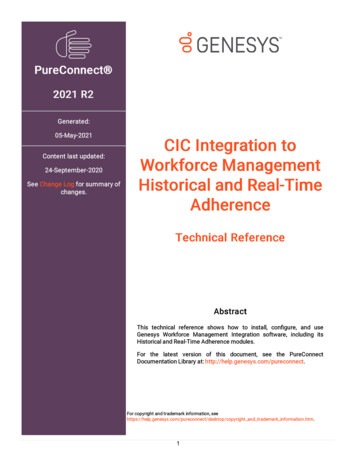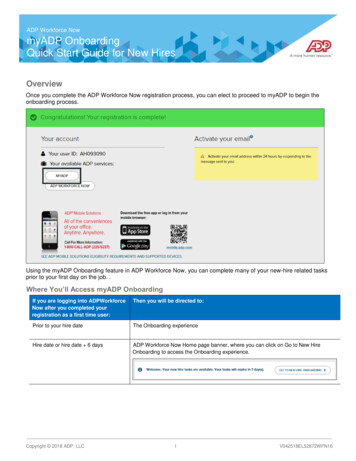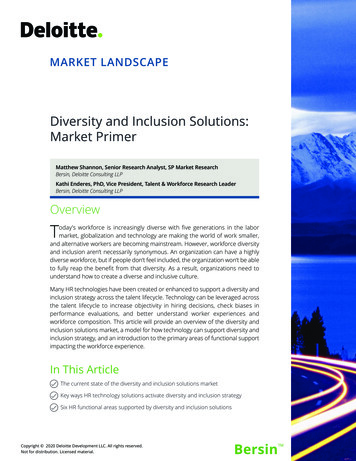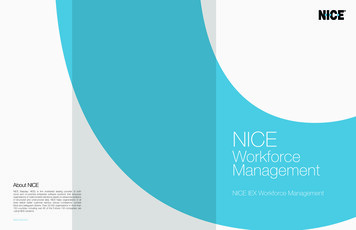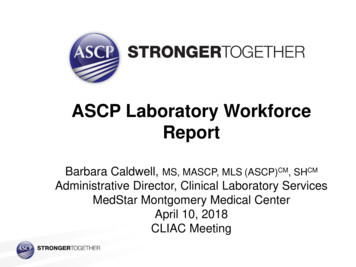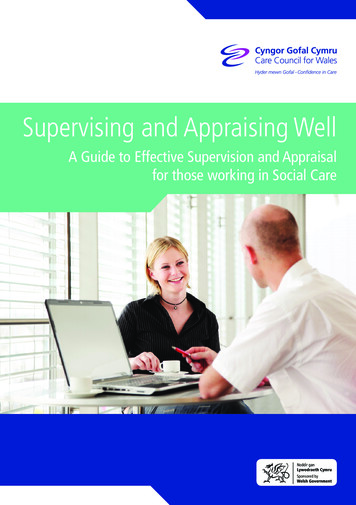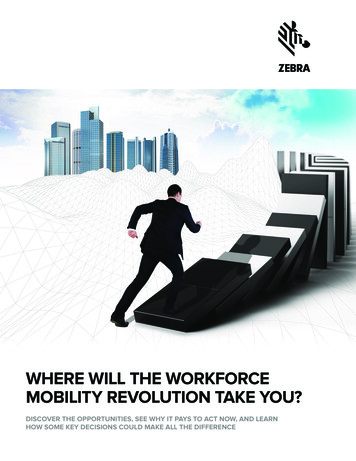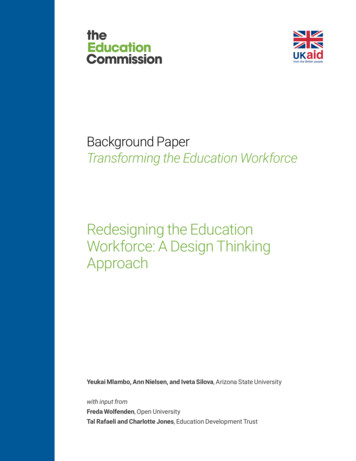
Transcription
Background PaperTransforming the Education WorkforceRedesigning the EducationWorkforce: A Design ThinkingApproachYeukai Mlambo, Ann Nielsen, and Iveta Silova, Arizona State Universitywith input fromFreda Wolfenden, Open UniversityTal Rafaeli and Charlotte Jones, Education Development Trust
The Education Workforce Initiative (EWI) was established in response to a recommendation from the Education Commission’sLearning Generation report to explore new ways of diversifying and strengthening the education workforce. The Transforming theEducation Workforce report is one of EWI’s key contributions to catalyzing this thinking. It draws on recent evidence and providesthought leadership on how to rethink the education workforce. For the full report and other supporting documents, please visitEducationWorkforce.org.The Transforming the Education Workforce report was originally commissioned as a set of sequential background papers and thuseach paper influenced and references the others. The background papers are written by different authors and cover the rationale forrethinking the education workforce, the design of the education workforce, how it can be strengthened, and political economy andfinancial considerations.This background paper focuses on redesigning the education workforce using a design thinking approach to propose design options forthe workforce needed now and in the future.For questions or more information about this paper, please contact: info@educationcommission.orgPlease reference this publication as: Mlambo, Yeukai, Ann Nielsen, and Iveta Silova (Arizona State University) with input fromFreda Wolfenden (Open University), Tal Rafaeli and Charlotte Jones (Education Development Trust). 2019. “Redesigning the EducationWorkforce: A Design Thinking Approach.” Background Paper for Transforming the Education Workforce: Learning Teams for a LearningGeneration. New York: Education Commission.
Executive summaryEducation systems face the challenge of attracting and retaining an effective education workforce, whilemeeting the needs of an increasingly diverse student population and keeping up with global trends includingrapidly advancing technological innovations. Unfortunately, the design of the education workforce in manycountries stems from the industrial age of mass production and has been hard-wired for delivering basicservices and infrastructure to promote economic growth. Now systems are charged with delivering qualityeducation which is committed to inclusion and strives for constant improvement. This requires different corecapabilities and changes to workforce practices and behaviors.Reimagining the education workforce to meet Sustainable Development Goal 4 requires a clear focus onenabling access, learning, equity, and inclusion. An education workforce for this century will succeed when allchildren are learning, when teachers and other members of the workforce are respected by society and giventhe support they need, and when the teaching and learning environment becomes a focus of the communityand not the sole responsibility of one teacher serving many students in one classroom. This workforce shouldbe underpinned by core capabilities and strong partnerships driven by the kind of resilient trust that allowspeople and institutions to share collaborative opportunities as well as take risks that contribute to advancingeffective teaching and learning. Achieving this requires a collaborative commitment to developing new habitsof mind and dispositions among the education workforce, policymakers, and communities, as well as changesin institutional structures and culture.This paper approaches the redesign of the education workforce by drawing on existing evidence of differentroles in the education workforce, a review of effective approaches to teaching and learning, and in-countryfieldwork we conducted in Ghana and Vietnam. Based on these findings, design principles were created toinform the process of redesigning the education workforce. These were then applied to create illustrations ofNEXT and FUTURE models of the workforce. Of course, each context is different so the models will varyaccording to each context’s specific needs. This paper offers considerations for policymakers and stakeholdersthat can assist in moving toward a desired education workforce model.While few examples exist of large-scale redesign of the education workforce, some examples of recentinnovations and initiatives point to new ways of thinking about the roles in the education workforce. While weacknowledge that more research is needed, existing evidence shows that: The role of the teacher has shifted allowing for greater student agency and personalized learning. Utilizing different types of teaching and learning roles at the classroom or school level can supportimproved learning, most importantly for the most marginalized. School leaders are most effective when they provide instructional leadership for teachers, create aculture of shared responsibility and professional collaboration among teachers; and understand howthe broader community can support learning. Multidisciplinary teaching and learning teams that include a mix of skills and expertise can allow teamsof teachers and other school professionals to be flexible and maximize their efforts in responding tostudent needs. Technology can expand learning opportunities and experiences for diverse students, allowing greaterdifferentiation of the teacher role and/or learning environments.1
Effective educational systems include a middle tier that provides strategic and instructional leadershipfor schools, facilitates peer collaboration between schools and teachers; and ensures smartaccountability based on data. (See background paper Redesigning the Education Workforce)To further inform our thinking, we also draw on what we know about what works to improve learning. Recentreports, including Transforming the Education Workforce report, The Learning Generation report, and the 2019World Development Report, identify several effective practices associated with the workforce to increaseaccess and learning outcomes. These include mother tongue/bilingual instruction, better teaching methods,remedial education, providing more teaching time, and providing teachers with more information on studentprogress. We have oriented the design toward these proven practices where appropriate.What could the FUTURE of the education workforce look like?Building on the existing evidence on workforce design and proven practices to enhance learning, and takinginto account the global trends, we recommend a set of design principles that can help guide policymakerswho seek to redesign their education workforce. An effective process of redesign will: Start with the needs of learners to determine the kinds of adult and technological expertise neededto be present, when, and in what ways. Move from a one-teacher, one-classroom model of education delivery to a team-based and communalresponsibility model in which teachers, as the key agents for delivering teaching and learning, are ableto focus on the teaching and learning needs of students and are supported by adults both in and outsideof the school learning space to provide holistic learning experiences. Recognize the diversity of both students and the education workforce and ensure that issues ofequity and inclusion and contextual and cultural relevance are considered in assembling the team ofteaching and learning professionals needed to deliver learning effectively. Be defined by the capabilities of the team, not just individuals, and consider how those capabilitiesalign with the changing needs of learners and learning environments. Acknowledge the skills and knowledge that the education workforce already possesses andprovide opportunities to cultivate these skills and develop new skills that contribute positively toteaching and learning, and building professionalism. Cultivate a culture of trust and shared responsibility that allows for creativity and flexibility as wellas some autonomy in decision-making across the various tiers of the ecosystem (e.g., classroom,school, middle-tier, and ministerial levels). Encourage use of evidence, innovation, reflection, and adaption — undertaking reflexive practicesaimed at improving learning; engaging in critical data-driven practices, encouraging a culture ofinnovation (e.g., leveraging technology where appropriate) and therefore the potential to leapfrogtraditional trajectories when appropriate. These innovative practices are then incorporated into the cycleof reflexivity. These workforce processes (feedback loops, cycles of continuous improvement, culturesof learning, etc.) are as important as the structures.Applying these guiding principles, we propose an incremental and progressive model of the educationworkforce redesign, which moves the current education workforce ecosystem into NEXT and FUTURE phasesof redesign. The NEXT phase is focused on addressing immediate challenges and needs and involvesleveraging existing resources, strengthening existing roles as well as introducing new roles where necessary to2
ensure teachers are supported in delivering education to marginalized populations (e.g., children withdisabilities). In the FUTURE, emphasis is on bolder redesign initiatives that aim to propel the educationworkforce toward a team-based and communal responsibility model of educational delivery, one which centersthe learners and their needs as the basis for determining which adults need to be in the room, with which skills,and for what purpose. The future education workforce model proposed requires us to break free from businessas usual, including breaking from the traditional understanding of the structure of the current education system.If we are to reimagine and redesign the education workforce, it requires us to acknowledge that the learningspaces themselves would shift, as would the roles required to deliver education in a changing world.This paper suggests that in addition to the design principles, the redesign of the education workforce must payattention to the following key considerations: Changes to educational ecosystems need to be attentive to local cultural and contextual needsincluding those that address inclusion. Interventions need to be respectful of the maturity of the system. The movement from one revolutionto the next may be swift for some education systems and slower paced for others. It is imperative that strategic thinking and design across education systems is embedded in theredesign of the education workforce. In thinking about redesigning the education workforce in specific contexts, it is essential that there aresystematic dialogues that ensure that the principles and goals of the ecosystem discussed are infusedin the functions of the different units as well as the roles and activities of each educator in the ecosystem.IntroductionWhile advances in curriculum, assessment and pedagogical practices, and teacher training have begun toreform educational systems, a critical analysis of who is (and who is not) included in the education workforcehas had less consideration. Teachers who are integral for student learning still largely operate in isolation fromeach other, rarely receiving effective feedback on their teaching from peers or school leaders. In addition, therole of the teacher has expanded, often requiring teachers to be experts in pedagogy and instruction, to teachmore diverse curricula, informally and formally assess student learning, foster child welfare, and undertake otheradministrative tasks while simultaneously managing overcrowded and under-resourced classrooms comprisingan increasingly diverse student body. Expansion of teacher roles and responsibilities coupled with significantteacher shortages exacerbate these challenges, as do limited accountability structures and support systems.As a result, many teachers in educational systems become overburdened and unmotivated, with negativeimpacts on teaching and learning (Winthrop et al, 2016; Wolfendon et al, 2018). This paper directs our attentionto reconsider the education workforce that surrounds students and classrooms, repositioning the challengesof the 21st century that educational systems face as an opportunity to revisit the entire education workforce.In framing this paper, we build on the work conducted by 2Revolutions (Sester & Morris, 2015; Kern & Rubin,2012). 2Revolutions presents a framework to guide engagement with innovative practices at both basic andsecondary school levels in the U.S. 2Revolutions argues that the rapid changes happening in the world,including growth in technology, shifts in policy environments, economic and other pressures on the traditionaldelivery of education, as well as growing dissatisfaction with the status quo, creates an opportunity to not justreform but to transform the education workforce (Sester & Morris, 2015). The framework provides a structurefor considering and responding to both the incremental and transformational redesign of the educationworkforce for this century by considering three phases that demand an understanding of the current education3
workforce and the system in which it operates as a starting point for any movement toward a desired future.Through identified principles, the current education workforce can be guided toward more incremental changesin the immediate NEXT phase, and ultimately toward a FUTURE long-term phase of transformational, bolderthinking (Figure 1). Understanding the NOW allows us to identify the strengths, weaknesses, opportunities, and threats ofthe current education workforce system that demand immediate attention and action. Understandingthe NOW requires engaging with teachers, school leaders, middle-tier staff, and other education deliverystakeholders from all levels of the ecosystem in order to have a holistic perspective of the currenteducation workforce and to determine how to address immediate needs while simultaneously planningfor the future. NEXT are the necessary immediate steps that address critical challenges identified in the now and helpeducation workforce ecosystems to move closer to a future vision in phases or steps, working with keystakeholders and moving in incremental ways that are measured and evaluated for improvement. Theremay be multiple NEXT phases until the end goal is achieved. The FUTURE represents the desired future model of the education workforce, the functions of eachindividual within each level or unit of the education system (e.g., school, district, ministry), the roles aswell as the activities that could exist to support the delivery of education in this century. Finally and most critical for education workforce redesign, each evolution of moving from NOW to NEXTand FUTURE needs to draw upon guiding principles that are collectively identified as necessary inpropelling an education workforce toward a desired future.In the following sections we begin with a review of existing research, introduce our fieldwork research that andconclude with considerations for various stakeholders including policy makers in order for this model to besuccessful.Figure 1: 2Revolutions approachAdapted from Todd Kern and Adam Rubin (2012) Designing the Future of Learning: Unthink school to rethink learning4
Existing evidence and case study examples of redesigning the educationworkforceInnovations in teacher rolesThere is a scarcity of large-scale, policy-driven examples of and robust data on workforce design or redesignat scale (Wolfenden et al, 2018). However, literature from the Organisation for Economic Co-operation andDevelopment (Paniagua & Istance, 2018; OECD 2018; Schleicher 2015). and other experts on the future ofeducation points to the changing role of the teacher, which is evolving to be more multifaceted and adaptivedepending on the context and students, and reveals several emerging characteristics of how teaching andlearning is already changing.For example, Innova Schools (low-cost private schools) in Peru combine teacher-led, project-based learningin small groups with student self-directed time using digital learning tools. Here, teachers monitor students’online work and offer personalized guidance. Such models are of course highly dependent on the availability ofinfrastructure, power, and access to the web and may not yet be feasible in more rural areas or urban areaswith limited energy access (PERU – OECD).At the Lumiar Institute in Brazil, there are no “traditional teachers”; instead, one half of the “pedagogical staff”work as advisors, mentors, and coaches, monitoring the students’ progress and supporting them to selectthree or four projects that they work on every term. The other half of the staff are “masters” of a particular setof skills, such as engineering or piano playing, and work part time to design and facilitate projects that equipstudents with these skills.The African School for Excellence, serving low-income families in South Africa, operates a “rotational” modelin their classrooms. Students rotate between teacher-facilitated lessons, small-group peer learning activities,and individual work on computers. This model places the teacher in the role of the facilitator (Winthrop et al,2016).The Escuela Nueva model for multigrade classrooms in which students of different ages learn together throughgroup discussions and projects also has the teacher taking on a facilitator role. Students work at their ownpace, showing that they can have agency over their learning and can be at the center of the learning process.The use of demonstration schools in the Escuela Nueva model enables teachers to see and experienceinnovations complemented by peer coaching from the demonstration schools (n.d.).In low and middle income countries there have been a number of initiatives that have explored how additional,differentiated roles working alongside the teacher can be complementary in providing targeted support withintheir classroom or supporting students in classrooms when specialist teachers are delivering instructionremotely. In some cases, in which there is a shortage of appropriately qualified teachers in a remote area,specialist teachers working with students across large geographical areas facilitated by a variety oftechnology have demonstrated improved learning outcomes. Examples include the Amazon Media Center inBrazil, the JAAGO program in Bangladesh (see Case Study 1) and MGCubed in Ghana (Case Study 2). TheJAAGO program is an example of an education system that mobilizes a wider range of adult stakeholders tosupport the delivery of education for children and young people as a communal activity. Local moderators,psychologists, recent graduates, and internet companies, as well as corporate entities, all work together tosupport and deliver education.5
Case Study 1: Example of innovation in education delivery to support access and learning for remote learnersand to address shortages of qualified teachers in remote locationsProgram: JAAGOCountry: BangladeshFocus: Technology-enabled use of qualified teachers to remote areasJAAGO, a Bangladesh-based NGO, provides quality teaching to a group of 12 remote online schools (3,000pupils) in 12 districts out of the Dhaka teacher center. The aim is to improve access to quality teaching forthe poorest children in the most remote districts at free, JAAGO-funded schools.Video lessons are led by English speaking graduates with teaching experience in collaboration with localclass moderators. Learners with multiple deprivations receive lessons in purpose-built, technology-equippedclassrooms. Families receive community officer support, and central expertise includes a psychologist tosupport learning difficulties and poverty-related issues of violence and early marriage.Local support moderators are educated to 12th grade. They facilitate group work and class management andare ready to take over if there is a connectivity problem. An initial challenge was teacher quality, and this hasdeveloped. The professional development package for moderators covers training, induction, andpreparation time to go through the syllabus. English phonics was a new topic covered in training. Qualitymonitoring is through supervision, visits, and software to observe classes.This technology-based interactive pedagogy represents a major change for communities and contrasts withgovernment schools in terms of ratio and resources. Classes are a mix of English and Bangla and resourcesinclude a full curriculum. Evaluations show that from a low base, 100% of those attending JAAGO primaryschools passed, and at junior high, 93% passed.Funding includes child sponsorship and multiple corporate partnerships. This includes an internet companyinvesting in the IT infrastructure where there was previously no internet. A local project officer providesoperational IT support. The technical challenges of bandwidth are ongoing.Future plans involve increasing the number of online schools and working with government on national youthIndevelopment.Ghana, the Making Ghana Girls Great initiative — “MGCubed” — leverages the skills of expert teacherswho broadcast literacy and numeracy lessons to rural schools where class teachers or facilitators facilitate theremedial lesson, together with a life skills program. This helps the local teachers improve their teaching,provides a way of addressing the challenges of expert teacher shortages and teacher absenteeism, whilepromoting girls’ education in remote districts.6
Case Study 2: Example of innovation in education delivery using technologyProgram: Making Ghana Girls Great (part of the Department for International Development’s Girls’ EducationChallenge)Country: GhanaFocus: Technology-enabled use of expert teachers across multiple school sitesFrom a studio in Accra, the Making Ghana Girls Great program delivers quality distance-learning video lessonsto marginalized girls in 88 rural schools in the most deprived communities. Using satellite digital technology,literacy and numeracy lessons are delivered by expert teachers in Accra and supported in the rural classroomsby trained local female facilitators, often the class teachers. Local technical officers support connectivitychallenges.In response to problems of teacher supply shortages, the aim of the intervention is to give students most atrisk of dropout greater quality learning time and to raise achievement and aspirations. The program takesaccount of the multiple community pressures on the most vulnerable girls.The facilitators lead remedial instruction in numeracy and literacy either in or after school according to localteacher shortages and needs. In addition, the program runs after-school Wonder Woman clubs with life skillssuch as financial literacy, gender norms, and interviews with local role models. By request, some sessionsare open to boys.Harnessing the expertise of master teachers and combining that with the training of high school graduates asfacilitators in a context of high unemployment and early marriage provides new status and a professionalpathway. The facilitators reinforce positive attitudes and are closely involved with the school committees. Anunintended consequence of the training and lesson observations has been the impact on the professionaldevelopment of teachers in the schools and wider area; for example, teachers leading training for othercolleagues and developing reading resources for whole-school literacy. Districts have also used the materialsfor wider in-service training and shared sessions on monitoring data and child safety. Plans includeaddressing the sustainability of this model.External evaluations show improvements in English and math scores, with math as especially significant, andTheSchool-Based Mentor role implemented in Rwanda involves specialist teachers acting as pedagogicout-of-schooladvisersworking within or across schools to mentor teachers, with the aim of improving teachers’ knowledgerates reduced.of English and pedagogical classroom practices. Despite some challenges around stakeholder buy-in, such asschool administrators not providing time in the daily schedule for mentors to meet with teachers, the mentorswere viewed positively by teachers. In addition to improving the English proficiency of teachers, the learnerbased approaches that these mentors introduced also contributed to the improvement of students’ literacy andproficiency levels with parents noting the changes in literacy skills they observed in their children (Buhungiro,2015).The use of teaching assistants can improve teaching and learning if adequate support for their training,indication, and deployment is in place. In Ghana, the Teacher Community Assistant Initiative utilized local highschool graduates to support teaching small groups of students in primary school with learning gains shown bychildren participating in the program. Volunteer support staff have also been shown to support learning. TheCAMFED learner guide program in Tanzania, Zimbabwe, Zambia, and Malawi (Case Study 3) offers alumni the7
opportunity to volunteer as mentors and role models at local secondary schools. This program has shownconsiderable impact on retention and learning for the most marginalized girls and provides a route into teachingfor CAMFED alumni. Other initiatives using community volunteers include the UNICEF/EQUIP program inTanzania. In this community, volunteers have demonstrated improved outcomes for children through a 15-weekschool readiness program (Pettersson, et al., 2015).Case Study 3: Example of community collaborators in supporting the delivery of education in schoolsProgram: CAMFEDCountries: Tanzania, Zimbabwe, Malawi, Ghana, ZambiaFocus: Use of female volunteer learning support staff from the local communityCampaign for Female Education — CAMFED — is an NGO supporting girls’ access to, and retention in,education. CAMFED learner guides are female peer mentors providing pastoral support to marginalized girlsin rural secondary schools in Africa.Unlike teachers posted from outside the area, learner guides are local volunteers with experience of povertychallenges. They act as a missing link between school and community, especially concerning health andwelfare issues. As insiders, they can build trust and offer psychosocial support.In return for 18 months’ support in school, learner guides receive a package of social benefits: classroomexperience and training, a mobile phone for data monitoring, and an interest-free microloan from Kiva.org.Using the loan to start local businesses, learner guides report increased earnings above poverty thresholds.They have a second chance to learn through learning resources linked to a vocational BTEC certificate,potentially a route to teacher training.In schools, learner guides lead in-school sessions in an innovative pastoral curriculum with materials basedon the My Better World books. Sessions cover self-esteem and financial literacy relationships, andacknowledge barriers beyond school. Boys are involved in some sessions. Evaluation shows increasedconfidence and questioning of gender norms for boys and girls and retention and engagement formarginalized girls. Pupils in participating schools demonstrated increases in their math and English scores.Funded by the Department for International Development since 2014, this program was piloted in Tanzaniaand Zimbabwe and extended to Malawi, Ghana, and Zambia. It has now involved nearly 6,000 learnerguides. Sustainability is built in through strengthening of parent-teacher associations and capacity buildingof formal management structures. Learner guides act as female role models, demonstrating the value ofeducation and qualifications and employment possibilities.The Sistema de Aprendizaje Tutorial model in Central and South America offers an alternative secondary schoolexperience for students in remote regions who are economically disadvantaged. Students are able to stay intheir communities and continue with their livelihood activities while studying a specific curriculum that is flexibleand relevant to their needs and is supported by tutors who stay with the same students for six years. Tutorsare positioned as co-learners with their students in a climate of mutual trust.8
Evidence from Glewwe and Malhadiran’s (2015) review of supplemental remedial instruction and teachingat the right level found “ several high-quality studies finding strong impacts of remedial instruction programson learning outcomes, even when implemented by volunteers or informal teachers with little formal training” (p.49). These include Pratham’s use of Balsakhis (informal “teachers” from the community) who took children inthird and fourth grade who had not achieved basic competencies in reading and arithmetic out of the regularclassroom for two hours per day and provided them with remedial instruction targeted at their current level oflearning (Dutt, Kwauk, & Robinson, 2016). This program improved students’ test scores (average of math andEnglish scores) by 0.14σ after one year of the program, and by 0.28σ after two years. Lakshminarayana, Eble,Bhakta et al. (2013) studied the impact of a program run by the Naandi Foundation which recruited communityvolunteers to provide remedial education to children in a randomly selected set of villages in Andhra Pradesh.The volunteers provided two hours of remedial instruction per day. After two years of this intervention, studenttest scores in program villages were 0.74σ higher than those in the comparison group. These indicate thebenefits of additional roles supporting the learning of those most behind.Glewwe and Malhadiran’s (2015) review also stated that “ overall, the evidence on pedagogy suggests thatthe quality of classroom pedagogy may be a key determinant of the extent to which increases in school inputsare trans
rethinking the education workforce, the design of the education workforce, how it can be strengthened, and political economy and nancial considerations. This background paper focuses on redesigning the education workforce using a design thinking approach to propose design


